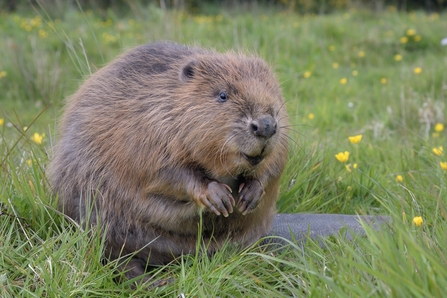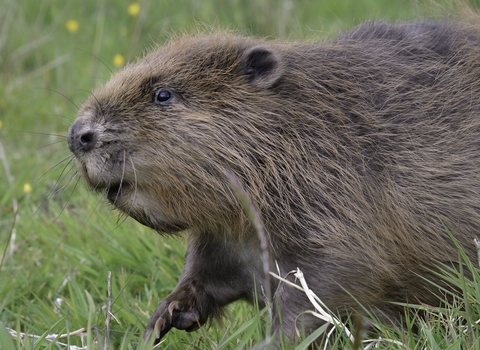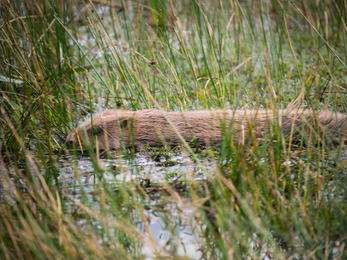Beavers in Britain
The Eurasian beaver (Castor fiber) is a large herbivore, a mammal that is native to these shores and was once widespread. Beavers played a crucial role in our wetland landscapes from prehistoric times, until they were hunted to extinction in the 16th century for their fur, meat and scent glands. The loss of this charismatic species also led to a loss of the mosaic of lakes, meres, mires, tarns and boggy places they so brilliantly build.
The Wildlife Trusts are working hard to bring these fantastic mammals back to Britain.
Why beavers?
This isn’t just about the reintroduction of a species – it’s about the reintroduction of an entire ecosystem that’s been lost.
Beavers are often referred to as ‘ecosystem engineers’. They work 24/7 to coppice trees and shrub species, damming smaller watercourses and digging ‘beaver canal’ systems. These activities create diverse and dynamic wetlands benefitting the wetland birds Idle Valley is known for, as well as otters, water voles, amphibians and invertebrates. The beavers allow communities of plants and animals to develop together in ways far more complex, and quicker than we could ever achieve with our own hands, as well as sequestering (storing) carbon.

Photo © Nick Upton
We’ve brought beavers back!
In November 2021 we released 8 beavers into our enclosure at Idle Valley Nature Reserve! Beavers, alongside our conservation grazing programme, allow us to harness the natural processes of this reserve and unlock more of the site’s potential for wildlife.
Beaver release at Idle Valley (https://youtu.be/KKG2oYu98wA)
Video by Nottinghamshire Wildlife Trust
David Parkyn / Cornwall Wildlife Trust
The work continues!
Want to learn more?
Experience from Europe
Reintroductions and translocations of Eurasian beaver have now taken place in more than 25 European countries. They began in the 1920s in Sweden, Norway, Latvia, Russia and the Ukraine and continued throughout the 1980s and 1990s in the Netherlands, Croatia, Bosnia and Herzegovina, Czech Republic, Denmark, Hungary, Romania and Slovakia.
Reintroductions usually involve the release of animals over a number of years to several sites. Most have been successful in terms of breeding, population growth and range expansion.
More than 150 translocations have now been undertaken across Europe, most without the detailed monitoring carried out by the Scottish Beaver Trial and other British projects, but some have been thoroughly studied, enabling scientists to predict with confidence the likely pattern of events post reintroduction. Experts and volunteers across Europe are able to manage problems that sometimes occur, for example in areas of arable production.
The economic impact of beavers
A study on the economic impacts of the beaver by the University of Oxford's Wildlife Conservation Research Unit concluded that "with forethought, prior consultation and planning, a beaver reintroduction should bring significant monetary benefits within the local economy and communities that could greatly outweigh any potential negative impacts.”
Research into the impact of beavers on the local economy around Knapdale Forest was carried out as part of the Scottish Beaver Trial and its results are currently being assessed by the Scottish Government. Local businesses reported an upturn in business due to interest in the Trial increasing visitor numbers to the area. There is also anecdotal evidence of an increase in beaver tourists to the River Otter in Devon.
The environmental impact of beavers
Beavers can modify the habitats and landscapes they live in through coppicing, feeding and in some cases damming (beavers living on lakes or rivers have little need of constructing dams). However in many cases when they are living at low density, their impacts can be remarkably subtle and go unnoticed for many years.
Beavers forage close to water with activity usually concentrated within 20 metres of the water’s edge. Beavers do fell broad-leafed trees and bushes to reach upper branches, encourage regrowth, to eat the bark during the winter and to construct their lodges. Many tree species regenerate, which diversifies the surrounding habitat structure and create areas of mixed-height, mixed-age vegetation. Coppicing has been practiced by foresters throughout history as a method to manage bankside trees. The actions of beavers are very similar, meaning woodlands and trees are more naturally managed.
Evidence from Europe shows that shows that beaver impacts are, in the vast majority of cases, small-scale and localised. Beavers are not normally regarded as pests in Europe and where localised problems have occurred, there are a number of well-established mitigation methods that can be adopted. These include the removal of dams, the introduction of overflow piping, or the installation of fencing (as one does for deer and rabbits). In some cases, the removal and translocation of beavers could be considered. Some countries with sustainable beaver populations permit seasonal hunting and/or lethal control as legitimate management strategies.
The impact of beavers on water management
By creating dams and associated wetlands in headwater streams, beavers store floodwater in upper catchments, moderating water flows. This reduces the height of flood peaks and also ameliorates low flows during dry periods as the leaking dams recharge streams with fresh constant flows. For those landowners impacted, these dams clearly cause localised “flooding” or raised water levels in wetland habitats. The size of these ponds and wetlands can be restricted by the use of flow devices where pipes set the maximum height of the dam, and thus the area of land flooded.
Beavers rarely build dams in main rivers downstream where there is sufficient depth of water, and so many of the concerns about flooding are not real. However in low lying floodplains where agricultural activities depend on land drains and deep ditches, beaver dams can have more significant impacts. They can obstruct culverts and “restore wetlands” in places that are not compatible with the existing land-uses and therefore create real, and perceived conflicts. In some cases mitigation measures will not be successful, and beavers may need to be moved on.
Evidence from elsewhere in Europe shows that instances of beaver dams creating undesirable flooding are uncommon, localised and usually small-scale. In these situations dams are simply removed or pipes (‘beaver deceivers’) are placed through them to manage water levels.
The impact of beavers on migratory fish
Beavers are herbivorous, so do not eat fish. Habitat modification by beavers, however, can have significant impacts on fish populations in some circumstances, and fisheries groups are often concerned about the potential impact of beaver dams on the movement of migratory fish.
The interaction between beaver activity and freshwater fisheries has been the subject of several reviews. Based on the combined results of an independent and systematic review of the literature and survey of expert opinion, Kemp et al. (2012) concluded that:
-
Benefits (184) were cited more frequently than costs (119)
-
Impacts were spatially and temporally variable and differed with species.
-
The most frequently cited benefits of beaver dams were increased habitat heterogeneity, rearing and overwintering habitat; flow refuge; and invertebrate production.
-
The most frequently cited negative impacts were impeded fish movement because of dams; siltation of spawning gravels (particularly for salmonids); and low oxygen levels in ponds.
-
The majority of 49 North American and European experts (more than 60% of whom described themselves as fisheries scientists or managers) considered beavers to have an overall positive impact on fish populations, through their influence on abundance and productivity.





